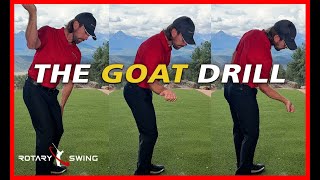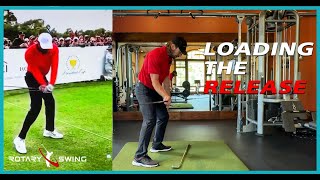If you have "Golfer's Elbow" or just want to learn a simple trick to square the club face every time at impact, read on.
Traumatic injury due to overuse and incorrect positioning of the lead elbow (left elbow in right handed golfers) is an extremely common and totally avoidable injury.
If I had a dollar for every time a golfer told me that his left elbow ached after golfing, I would be a rich man.
For many, this common issue leads to painful injections or even corrective surgery; sometimes, the golfer simply quits playing all together.
Of course, just by learning the simple fundamental in this video, you can completely avoid injury to the elbow and enjoy the game again, pain free.
As an added bonus, you will be able to square the club face consistenly at impact and have a specific checkpoint during practice to start hitting the ball straighter and on a more penetrating trajectory.
The first step to enjoying all these benefits is to make sure your elbow doesn't look like this at impact...
The video goes into detail about why it can be very dangerous to listen to the TV commentators when they futilely try to dissect a PGA Tour player's swing and actually recommend the harmful position above.
As you will see, even common sense would tell you that having your elbow in the position they advocate—with the elbow "pit" facing directly away from you—is dead wrong and is the leading cause of trauma to the left elbow in right handed golfers.
Fortunately, you get your golf instruction at RotarySwing.com, where we verify the biomechanical and anatomical safety of every movement and position.
Now that you know what not to do, you need to watch the video to learn the proper movement and positioning of the lead elbow.
It's simple to understand and gives you all this:
- Puts the elbow in a safe position so that it will naturally bend to absorb shock from striking the ground.
- Teaches you to properly square the club face at impact.
- Delofts the club for longer, more penetrating golf shots.
If you could use all that in your golf swing, then check out this video now!
"Went to the range to try this, now I know where those quick hooks come from!!! Anxious to try it out on the course. Now I feel like I can release as much as I want and not go left!!!"
-Randall B. | Aug 21, 2012 | 5 HDCP
Video Transcription: Left Elbow at Impact
One of the most unfortunate things for a lot of golfers is they listen to what the TV pundits say when they're watching a golf telecast. Unfortunately, 99 percent of the time, if they're talking about the golf swing they're wrong.
I know that sounds like a pretty bold statement to say, but we have reasons for all that. One of the things that we hear pretty often, and I heard a golf pundit say recently, is that your left elbow at impact should be pointing back this way, or your arm externally rotated.
There's a couple of reasons you don't' want to do this, and I'll give you an example in just a moment, but let's talk about what we do want to do first - that's a lot easier.
Your elbow needs to be pointing down the target line, or close to it, at impact. I can just say that, and say, "Oh, that's the way it is," but that's not how we do things with RST. Everything has a reason and a justification, and a very logical answer for that. I'm going to give you two of them.
Next time you hear this on TV, and you hear some pundit talking about how your arm should be like this, I'm going to tell you why that's wrong.
First of all, one of the big key, central things to RST is injury prevention. That's why we have orthopedic surgeons on our Medical Panel. They help us understand these things. That's a primary motivator for everything that we do in the swing. We're always worried about whether or not this is going to create injury in the long term.
Of course, if your elbow is like this, where your pit is pointing out away from you at impact, you are going to get injured. In fact, at one of the last clinics I had somebody who was doing that at impact. He said, "Oh, my elbow is really sore, doing this drill."
I'm like, "That's because you're not doing it correctly," and it was because of the way that he had his elbow at impact.
Let's look at this. I'm going to put my elbow where I want it, so it's internally rotated. My elbow is pointing more or less down the target line. Here's what's going to happen.
If I come into impact, and I come in a little heavy - let's say I catch it just a little chunky, or the ground is really hard, or I just hit lots and lots of balls and it's creating a lot of stress on here - I come in heavy, my elbow is going to bend this way. There's no trauma in that. Your elbow is designed to do that.
Let's say I come in a little heavy, I hit it a little steep on some hard ground. I come in, my elbow is just going to bend, it's going to absorb all the energy, zero injury. Your arm does this all the time. It's not ever going to get hurt doing that.
Now let's hit that same shot and have our arm externally rotated. Guess what happens when you hit that fat shot or that steep shot, or you just hit lots of balls, you hit balls off mats, especially.
This is where a lot of people get golfer's elbow in the left arm hitting off mats, especially during the winter, because your elbow, the bone, is crushing up into the humerus bone and smashing this, every time. You're just crushing that cartilage and you can run into all kinds of injury issues because the elbow can't bend this way; it only bends this way.
When it's externally rotated, all you're doing is just jamming those bones together at impact, thousands and thousands of times as you hit thousands and thousands of balls. Of course you're going to get some issues there.
It's a terrible, terrible piece of advice. For that reason alone, and nothing else, if I didn't say anything else, why you wouldn't want to do that. You need to have your arm internally rotated so the elbow is down the target line, so that from hitting thousands of balls your arm, if you come in a little steep, no injury problems whatsoever. That's reason number one.
Number two is squaring the club face at impact, so we've got two reasons for this that are really, really big. Once my arm is externally rotated my hand, to get the club face back square at impact, basically moves through close to its full range of movement here. I can't rotate these wrist bones with my elbow in this position any farther.
I'm just twisting my wrist bones here like this. That's as far as I can turn them. Well guess what? That club face is square.
Now, if I go any farther than that, which I can't, that's the whole thing. My swing is done. I know where impact is - I have a checkpoint here. My elbow is pointing down the target line, my hand is at near max range of motion.
I've taken out all this excess movement here, versus if I allow my arm to be like this; now I move through external rotation, now my club face is slung completely shut. Now it becomes a training issue to learn how much to rotate all of that through impact where everything's moving super-fast, versus everything just going to square and being at its range of motion.
I don't have to guess about where my hands and arms and elbows should be at impact. I just move them as far as they'll go, and keep releasing it as hard as I want. The ball's never going to go left.
When I see a lot of golfers who hook it quite a bit, it's typically because they are in a position with this elbow that allows them to really shut the face down really hard, so they can flip it over really quick, and that's what allows them to hit a lot of quick hooks, so they have to really time everything really well, versus just getting your joints aligned where they can't really move any farther.
Now all of a sudden I can't hit it left because my club face, if I get into that position, it's as square as it's going to be. All I do is just keep moving into that position, so it's easy to check. I'm just at my full range of motion, or close to it - piece of cake.
For those two very important reasons alone - squaring the club face, kind of important to golf, and not breaking your arm every time you hit off a hard surface, or hitting just lots of balls - you don't want to take that advice that says, "Oh, your elbow should be tucked into your side here," then all of a sudden you're going to start having elbow issues.
If your elbow hurts and you're hitting flip hooks, check the position of your left elbow at impact.
Watch part 2 now to see how you're moving your body in the opposite direction of the pros!

































































































































































































































































































































































































































































































